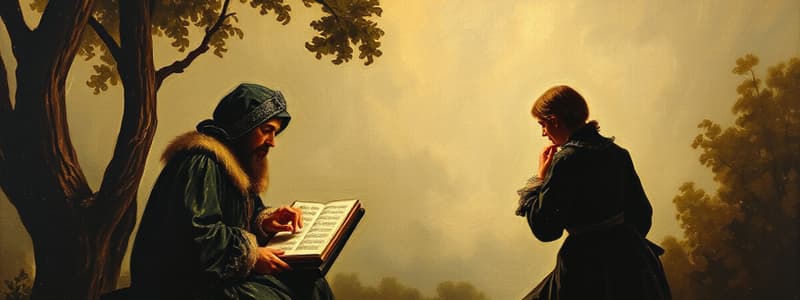Podcast
Questions and Answers
What genre is represented by the term 'Fugue'?
What genre is represented by the term 'Fugue'?
- Concerto
- Symphony
- Fugue (correct)
- Opera
Which musical period is associated with the term 'Baroque'?
Which musical period is associated with the term 'Baroque'?
- Romantic
- Baroque (correct)
- Classical
- Modern
Who is the composer of Little Fugue in G minor?
Who is the composer of Little Fugue in G minor?
G.D Bach
What texture is primarily used in Little Fugue in G minor?
What texture is primarily used in Little Fugue in G minor?
Describe the line characteristic in Little Fugue in G minor.
Describe the line characteristic in Little Fugue in G minor.
How is the pulse described in the rhythm of Little Fugue in G minor?
How is the pulse described in the rhythm of Little Fugue in G minor?
What is the meter used in Little Fugue in G minor?
What is the meter used in Little Fugue in G minor?
How would you describe the rhythmic patterns in Little Fugue in G minor?
How would you describe the rhythmic patterns in Little Fugue in G minor?
What form does Little Fugue in G minor take?
What form does Little Fugue in G minor take?
What is the pitch of Little Fugue in G minor?
What is the pitch of Little Fugue in G minor?
What type of color is featured in Little Fugue in G minor?
What type of color is featured in Little Fugue in G minor?
Flashcards are hidden until you start studying
Study Notes
Genre
- The piece is a fugue, a contrapuntal composition with a main theme introduced by one voice and subsequently imitated by others.
Period
- Composed during the Baroque period, characterized by its ornate styles and expressive music.
Composer
- Written by Johann Sebastian Bach, a pivotal figure in Western music history known for his mastery of counterpoint.
Texture
- Primarily polyphonic, featuring multiple independent voices that intertwine to create a complex sound.
Line
- The melodic line is described as very angular, emphasizing dramatic and sharp movements within the music.
Rhythm: pulse
- Strong and driving pulse creates a sense of momentum, propelling the music forward, contributing to its energy.
Rhythm: meter
- The piece is set in a duple meter, typically reflecting a two-beat feel that influences its rhythmic structure.
Rhythm: rhythmic patterns
- Recognizable rhythmic patterns which help to establish the identity of the piece and facilitate listener engagement.
Form
- Structured as a fugue, highlighting the intricate interplay of voices and development of musical themes.
Pitch
- The primary key of the piece is g minor, which adds a somber and reflective quality to the music.
Color
- Instrumentation features the organ with three parts played simultaneously, allowing for rich harmonic textures and sonorities.
Studying That Suits You
Use AI to generate personalized quizzes and flashcards to suit your learning preferences.




